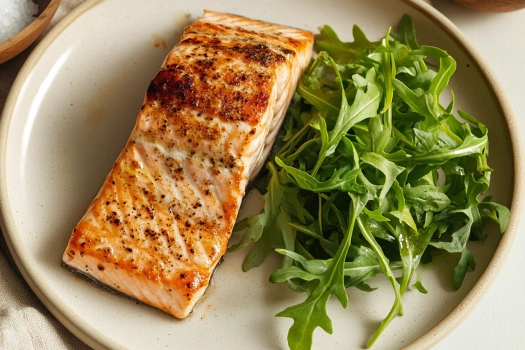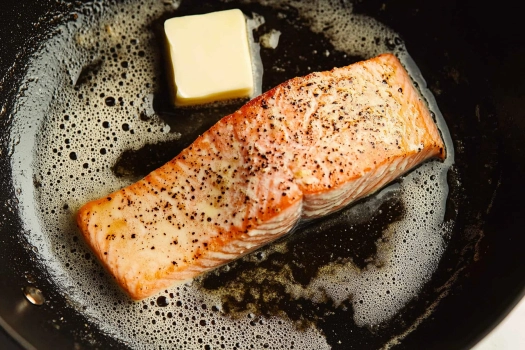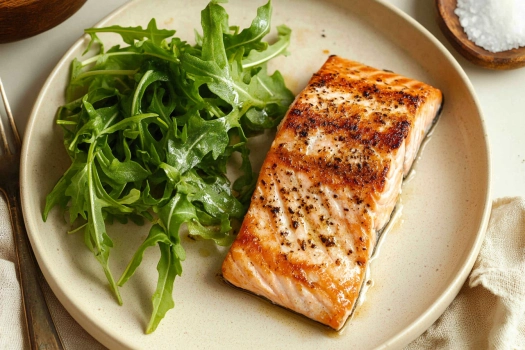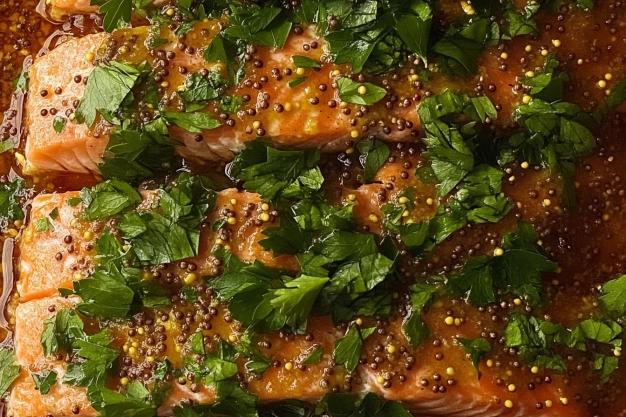
Juicy, tender salmon fillets cooked to perfection and here’s the best part: no white stuff! This is the go-to guide for cooking salmon that looks as good as it tastes. Plus, you’ll only need a handful of ingredients: butter, water, salt, and pepper.
If you’re here, you’ve probably dealt with the infamous “white stuff” that oozes out of salmon while cooking. It’s frustrating, isn’t it? You buy a gorgeous fillet, cook it with love, and suddenly it’s covered in white goo. Let’s fix that!
What Is the White Stuff on Salmon?
The white stuff is albumin, a protein that’s naturally found in salmon. When exposed to heat, it coagulates and rises to the surface. While completely safe to eat, it’s not exactly appealing. Luckily, you can minimize or even eliminate it by following a few simple steps.
Ingredients You’ll Need
- 2 Salmon Fillets (fresh or frozen, thawed)
- 8-10 Cups Cold Water
- 3 Tbsp Kosher Salt
- 1 Tsp Black Pepper
- 2 Tbsp Unsalted Butter

How to Cook Salmon Without the White Stuff
1. Brine the Salmon
Brining is the secret weapon for preventing albumin. Here’s how:
- Mix 1 cup of salt per gallon of water (or 1/4 cup salt for 4 cups water) until dissolved.
- Submerge the salmon fillets in the saltwater solution for 30 minutes to 1 hour.
- Pat the fillets dry with a paper towel after brining. No rinsing required!
2. Start with a Cold Pan
- Place the salmon fillets skin-side down in a cold, non-stick pan. This helps the fish cook evenly and gently.
- Turn the heat to medium and cook until the salmon is 1/3 to 1/2 cooked through (about 6-8 minutes).

3. Flip, Remove Skin, and Add Butter
- Carefully flip the fillets using a spatula. If you’re not a fan of salmon skin, now’s the time to remove it.
- Add butter to the pan and continue cooking for another 5 minutes or until the internal temperature reaches 120°F.
Why Brining Works
Brining isn’t just for flavor. It helps salmon retain moisture and reduces albumin buildup during cooking. Think of it as a quick saltwater spa for your fillets. Just don’t brine them too long — 30 to 120 minutes is ideal.
Tips for Perfectly Cooked Salmon
- Use a Food Thermometer: The magic number is 120°F for moist, tender salmon.
- Room Temperature Matters: Let your salmon rest at room temperature for 15-20 minutes before cooking.
- Don’t Overcook: Salmon cooks quickly. Once it flakes easily with a fork, it’s done.
Frequently Asked Questions

The white stuff, called albumin, appears when salmon is cooked too quickly or at high heat. To minimize it, brine the salmon beforehand and cook at a moderate temperature.
To prevent salmon from turning white, cook it gently at medium to low heat, either by baking at 350°F (175°C), pan-searing over medium heat, or poaching. The goal is to cook it just until the flesh is opaque and flakes easily with a fork. Using a food thermometer, aim for an internal temperature of 125°F to 130°F (52°C to 55°C).
Rinsing salmon isn’t necessary and may spread bacteria around your kitchen. Pat it dry with a paper towel instead to ensure a nice sear and better texture.
The white stuff, albumin, can also appear in salmon patties, especially if the patties are overcooked. To avoid this, cook the patties over medium heat and remove them as soon as they are cooked through. Properly mixing your salmon mixture and not overworking it can also help reduce albumin leakage.
Cooking time depends on the method and fillet thickness:
Fresh salmon should have a mild, ocean-like smell, a firm texture, and a vibrant pink or orange color. If your salmon smells overly fishy, sour, or like ammonia, it’s spoiled. Additionally, if the flesh is slimy or discolored, it’s time to discard it.

- Baking: 12-15 minutes at 375°F (190°C).
- Pan-Searing: 3-4 minutes per side over medium heat.
- Grilling: 4-5 minutes per side on a preheated grill.
Check for an internal temperature of 125°F to 130°F.
How to Tell If Raw Salmon Is Bad?
Fresh salmon should:
- Smell mildly of the ocean (not fishy or sour).
- Have a firm texture and vibrant pink or orange color.
If it smells off or looks slimy/discolored, it’s time to toss it.
What to Pair with Perfectly Cooked Salmon
- Easy Asian Cucumber Salad
- Israeli Couscous Salad
- Kale Fennel Dried Fig Salad
- Cold Soba Noodle Salad
- Garlic Mashed Potatoes
Related Recipes to Try

Final Thoughts
Cooking salmon without the white stuff isn’t just possible; it’s incredibly easy. By brining your fillets and cooking them gently, you’ll get perfectly moist, flavorful fish every time. Now that you’re armed with this knowledge, let’s turn your salmon game up a notch!
If you found this guide helpful, pin it for later or share it with your friends. Happy cooking!
How to Cook Salmon Without That White Stuff
- Total Time: 1 hour 15 minutes
- Yield: 2 servings 1x
Description
Juicy, tender salmon fillets cooked to perfection — and here’s the best part: no white stuff! Learn the steps to cook salmon that looks as good as it tastes, with just a handful of ingredients.
Ingredients
- 2 Salmon Fillets (fresh or frozen, thawed)
- 8–10 Cups Cold Water
- 3 Tbsp Kosher Salt
- 1 Tsp Black Pepper
- 2 Tbsp Unsalted Butter
Instructions
- Mix 1 cup of salt per gallon of water (or 1/4 cup salt for 4 cups water) until dissolved.
- Submerge the salmon fillets in the saltwater solution for 30 minutes to 1 hour.
- Pat the fillets dry with a paper towel after brining. No rinsing required!
- Place the salmon fillets skin-side down in a cold, non-stick pan.
- Turn the heat to medium and cook until the salmon is 1/3 to 1/2 cooked through (about 6-8 minutes).
- Carefully flip the fillets using a spatula. Remove the skin if desired.
- Add butter to the pan and continue cooking for another 5 minutes or until the internal temperature reaches 120°F.
Notes
Brining helps salmon retain moisture and reduces albumin buildup during cooking. Avoid brining for more than 2 hours, as it could make the fish overly salty.
- Prep Time: 1 hour
- Cook Time: 15 minutes
- Category: Main Course
- Method: Pan-Searing
- Cuisine: American
Nutrition
- Serving Size: 1 fillet
- Calories: 250
- Sugar: 0g
- Sodium: 800mg
- Fat: 15g
- Saturated Fat: 7g
- Unsaturated Fat: 8g
- Trans Fat: 0g
- Carbohydrates: 0g
- Fiber: 0g
- Protein: 23g
- Cholesterol: 60mg
